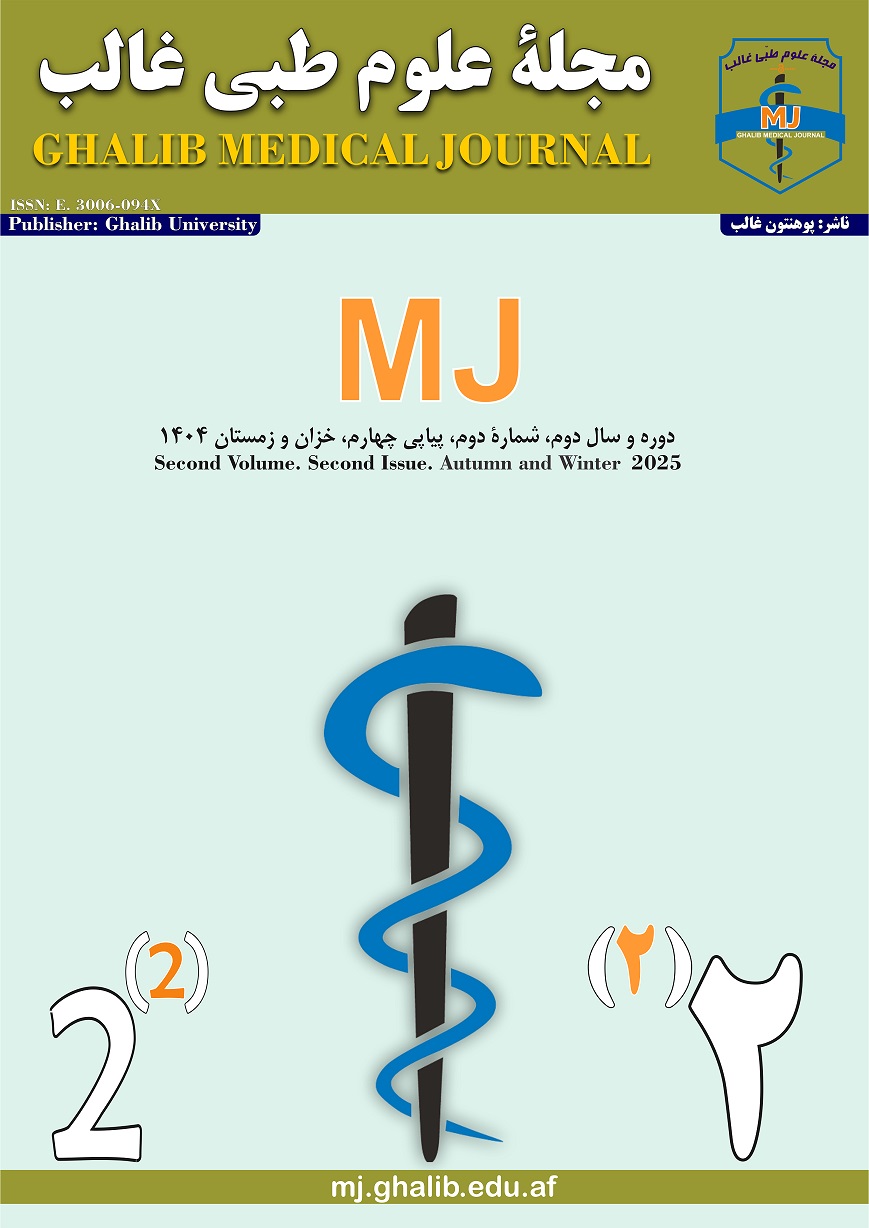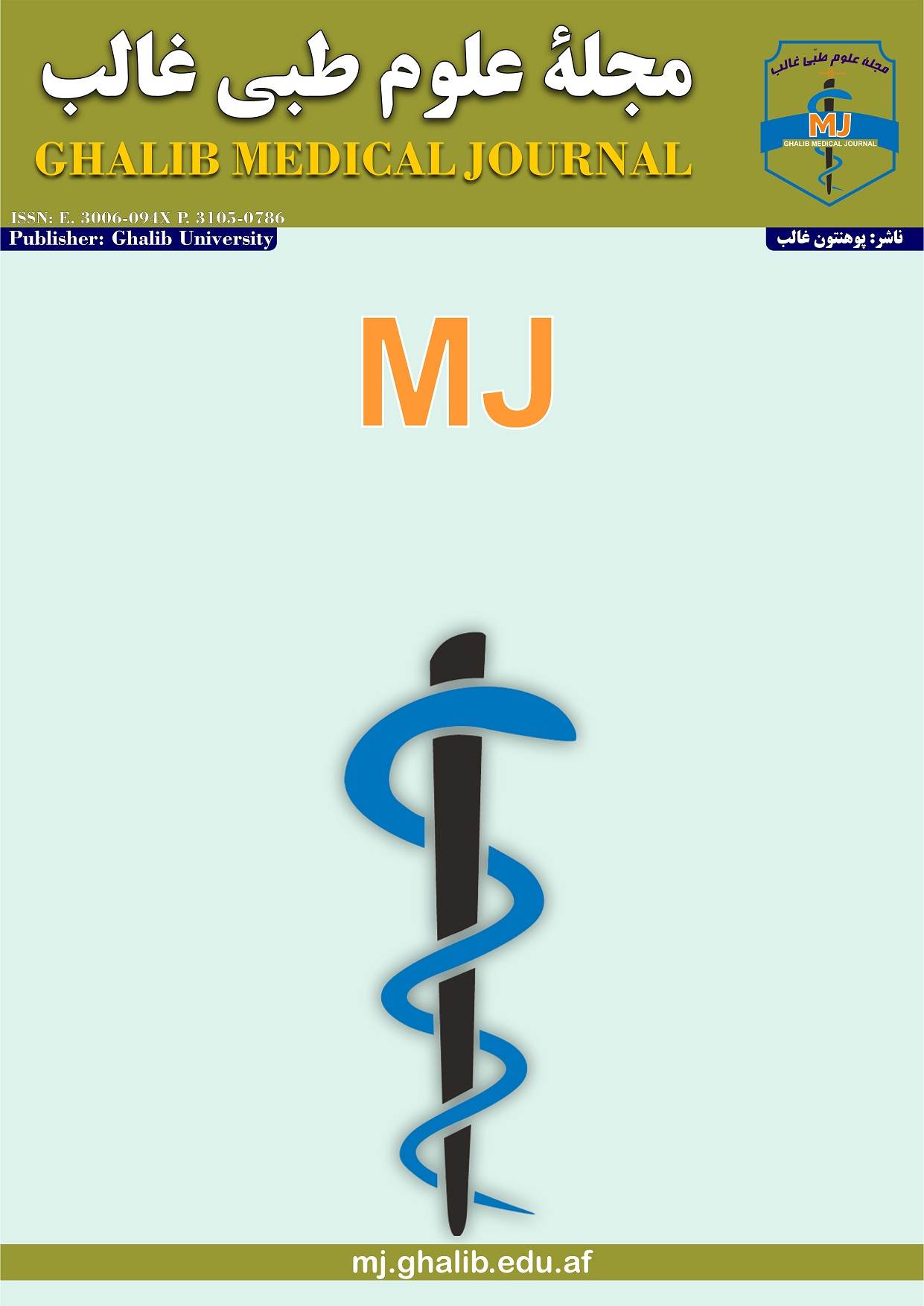شیوع هالیتوزیس در مریضان مبتلا به پریودنتیت: یک مرور سیستماتیک و متاآنالیز
DOI::
https://doi.org/10.58342/ghalibMj.V.2.I.2.2واژهگانِ کلیدی:
هالیتوزیس، بوی بد دهان، پریودنتیت، ترکیبات گوگرد فرّارچکیده
زمینه و هدف: هالییتوزیس یا بوی بدن دهان ۲۲ تا ۵۰ درصد بزرگسالان جهان را مبتلا میسازد که پریودنتیت یا التهاب انساج پریودنتال به عنوان یک عامل اتیولوژیک مهم برای هالیتوزیس محسوب میشود. با وجود اینکه همبستگی آماری بین آنها ثابت شده است، شیوع گزارش شده در مریضان مبتلا به پریودنتیت دامنه وسیعی (۳۷٪ تا ۸۱.۷٪) داشته که ناهمسانی میتودولوژیک را نشان میدهد. تاکنون هیچ میتاآنالیز با استفاده از سنجشهای عینی ترکیبات گوگردی فرار (VSC)، شیوع تجمیعی را کمّیسازی نکرده است.
روش تحقیق: بر اساس دستورالعملهای PRISMA ۲۰۲۰، بهطور سیستماتیک پایگاههای PubMed، Cochrane، Wiley و Google Scholar را در بازه سالهای ۲۰۰۰ تا ۲۰۲۵ جستجو کردیم. مطالعات مشاهدهای که هالیتوزیس را با روشهای عینی (کروماتوگرافی گازی/ مانیتورهای سولفید) در مریضان مبتلا به پریودنتیت گزارش کرده بودند، وارد مطالعه هذا شدند. خطر سوگیری با استفاده از ابزار هوی (Hoy) ارزیابی شد. متاآنالیز با مدل اثرات تصادفی انجام شد و برای بررسی منابع ایجاد کننده ناهمسانی، تفسیر و تحلیل کیفی صورت گرفت.
یافتهها: نه مطالعه (529 مریض ) مورد تحلیل قرار گرفت. شیوع تجمیعی هالیتوزیس (95% CI: 46.6–75.4%) 62.0%بود، اما ناهمسانی قابلتوجهی وجود داشت I² = 85.77%) ، τ²=0.53، p<0.001 ). تحلیل کیفی چند منبع مهم ناهمسانی را شناسایی کرد: اول، معیارهای تشخیصی پریودنتیت (طبقهبندی 2018 AAP/EFP در مقایسه با آستانههای (PD؛ دوم، روشهای سنجش ترکیبات گوگرد فرار (کروماتوگرافی گازی در مقایسه با مانیتورهای سولفید)؛ سوم، آستانههای تشخیصی VSC (140-80 ppb)؛ چهارم، ناسازگاری در ارزیابی پوشش زبان (WTCI در 4 مورد از 9 مطالعه استفاده شده بود).
نتیجهگیری: تقریباً دوسوم مریضان مبتلا به پریودنتیت دچار هالیتوزیسِ تأییدشده به صورت عینی هستند. ناهمسانی بالا مانع از ارائه یک برآورد قطعی از شیوع هالیتوزس در مریضان نام برده، میشود. مسئله اخیرالذکر بیان گر این است که پروتکلهای تشخیصی استاندارد در زمینه موضوع ضرورت است.
مراجع
Alzoman H. The association between periodontal diseases and halitosis among Saudi patients. The Saudi Dental Journal. 2021;33(1):34-8. Available from: https://doi.org/10.1016/j.sdentj.2020.02.005
Lee YH, Shin SI, Hong JY. Investigation of volatile sulfur compound level and halitosis in patients with gingivitis and periodontitis. Sci Rep. 2023;13(1):13175. Available from: https://doi.org/10.1038/s41598-023-40391-3
Ayo-Yusuf OA, Postma TC, van Wyk C. Clinical correlates of oral malodour in a population of patients attending a preventive clinic in Pretoria, South Africa. Sadj. 2011;66(7):326, 8-31. Available from: https://pubmed.ncbi.nlm.nih.gov/23198466
Izidoro C, Botelho J, Machado V, Reis AM, Proença L, Alves R, et al., editors. Intra-Oral Halitosis in Periodontitis: The Role of Tongue Coating—A Cross-Sectional Study. Medical Sciences Forum; 2023: MDPI.
Bollen CM, Beikler T. Halitosis: the multidisciplinary approach. International journal of oral science. 2012;4(2):55-63. Available from: https://doi.org/10.1038/ijos.2012.39
Szalai E, Tajti P, Szabo B, Koi T, Hegyi P, Czumbel LM, et al. Organoleptic and halitometric assessments do not correlate well in intra-oral halitosis: a systematic review and meta-analysis. Journal of Evidence-Based Dental Practice. 2023;23(3):101862. Available from: https://doi.org/10.1016/j.jebdp.2023.101862
Armstrong BL, Sensat ML, Stoltenberg JL. Halitosis: a review of current literature. American Dental Hygienists' Association. 2010;84(2):65-74. Available from: https://pubmed.ncbi.nlm.nih.gov/20359417
Soares LG, Castagna L, Weyne S, Silva D, Falabella M, Tinoco E. Halitosis Related Parameters from Patients with Chronic Periodontitis. EC Dental Science. 2015;2:284-92. Available from: https://www.researchgate.net/publication/290955160
Yaegaki K, Brunette DM, Tangerman A, Choe Y-S, Winkel EG, Ito S, et al. Standardization of clinical protocols in oral malodor research. Journal of breath research. 2012;6(1):017101. Available from: https://dx.doi.org/10.1088/1752-7155/6/1/017101
Izidoro C, Botelho J, Machado V, Reis AM, Proença L, Alves R, et al. Periodontitis, Halitosis and Oral-Health-Related Quality of Life-A Cross-Sectional Study. J Clin Med. 2021;10(19). Available from: https://doi.org/10.3390/jcm10194415
Savage A, Eaton KA, Moles DR, Needleman I. A systematic review of definitions of periodontitis and methods that have been used to identify this disease. Journal of clinical periodontology. 2009;36(6):458-67. Available from: https://doi.org/10.1111/j.1600-051X.2009.01408.x
Monfort Codinach M, Chimenos Küstner E, Alburquerque R, López López J. Update of intra and extra oral causes of halitosis: A systematic review. Oral Health and Dental Management, 2014, vol 13, num 4, p 975-981. 2014. Available from: https://hdl.handle.net/2445/67556
Apatzidou A, Bakirtzoglou E, Vouros I, Karagiannis V, Papa A, Konstantinidis A. Association between oral malodour and periodontal disease-related parameters in the general population. Acta Odontologica Scandinavica. 2013;71(1):189-95. Available from: https://doi.org/10.3109/00016357.2011.654259
Memon MA, Memon HA, Muhammad FE, Fahad S, Siddiqui A, Lee KY, et al. Aetiology and associations of halitosis: a systematic review. Oral diseases. 2023;29(4):1432-8. Available from: https://doi.org/10.1111/odi.14172
Tonzetich J. Production and origin of oral malodor: a review of mechanisms and methods of analysis. Journal of periodontology. 1977;48(1):13-20. Available from: https://doi.org/10.1902/jop.1977.48.1.13
Silva MF, Cademartori MG, Leite FRM, López R, Demarco FF, Nascimento GG. Is periodontitis associated with halitosis? A systematic review and meta-regression analysis. Journal of Clinical Periodontology. 2017;44(10):1003-9. Available from: https://doi.org/10.1111/jcpe.12786
Nini W, Chen L, Jinmei Z, Lufei W, Jingmei Y. The association between halitosis and periodontitis: a systematic review and meta-analysis. Clinical Oral Investigations. 2024;28(6):341. Available from: https://doi.org/10.1007/s00784-024-05732-0
Quirynen M, Dadamio J, Van den Velde S, De Smit M, Dekeyser C, Van Tornout M, et al. Characteristics of 2000 patients who visited a halitosis clinic. Journal of clinical periodontology. 2009;36(11):970-5. Available from: https://doi.org/10.1111/j.1600-051X.2009.01478.x
Vandekerckhove B, Van den Velde S, De Smit M, Dadamio J, Teughels W, Van Tornout M, et al. Clinical reliability of non‐organoleptic oral malodour measurements. Journal of clinical periodontology. 2009;36(11):964-9. Available from: https://doi.org/10.1111/j.1600-051X.2009.01473.x
Tangerman A, Winkel E. The portable gas chromatograph OralChroma™: a method of choice to detect oral and extra-oral halitosis. Journal of breath research. 2008;2(1):017010. Available from: https://doi.org/10.1088/1752-7155/2/1/017010
Page MJ, McKenzie JE, Bossuyt PM, Boutron I, Hoffmann TC, Mulrow CD, et al. The PRISMA 2020 statement: an updated guideline for reporting systematic reviews. bmj. 2021;372. Available from: https://doi.org/10.1136/bmj.n71
Silva MF, Leite FR, Ferreira LB, Pola NM, Scannapieco FA, Demarco FF, et al. Estimated prevalence of halitosis: a systematic review and meta-regression analysis. Clinical oral investigations. 2018;22:47-55. Available from: https://doi.org/10.1007/s00784-017-2164-5
Bossy A, Kulkorni G, Rosenberg M, McCulloch C. Relationship of oral malodor too periodontitis: evidence of independence in discrete subpopulation. Journal of Periodontol. 1994;65:37-46. Available from: https://doi.org/10.1902/jop.1994.65.1.37
Heitz‐Mayfield LJ. Conventional diagnostic criteria for periodontal diseases (plaque‐induced gingivitis and periodontitis). Periodontology 2000. 2024;95(1):10-9. Available from: https://doi.org/10.1111/prd.12579
Van den Broek AM, Feenstra L, de Baat C. A review of the current literature on aetiology and measurement methods of halitosis. Journal of dentistry. 2007;35(8):627-35. Available from: https://doi.org/10.1016/j.jdent.2007.04.009
AlMadhi NA, Sulimany AM, Alzoman HA. Halitosis and Associated Risk factors in children: a cross-sectional study. The journal of contemporary dental practice. 2021;22(1):51-5. Available from: https://doi.org/10.5005/jp-journals-10024-3017
Corporation I. Interpreting Halimeter readings2012. Available from: https://www.halimeter.com/interpreting-halimeter-readings/.
Hoy D, Brooks P, Woolf A, Blyth F, March L, Bain C, et al. Assessing risk of bias in prevalence studies: modification of an existing tool and evidence of interrater agreement. Journal of clinical epidemiology. 2012;65(9):934-9. Available from: https://doi.org/10.1016/j.jclinepi.2011.11.014
Suurmond R, van Rhee H, Hak T. Introduction, comparison, and validation of Meta‐Essentials: a free and simple tool for meta‐analysis. Research synthesis methods. 2017;8(4):537-53. Available from: https://doi.org/10.1002/jrsm.1260
van Rhee H, Suurmond R, Hak T. User manual for Meta-Essentials: Workbooks for meta-analyses (Version 1.3). 2018. Available from: https://doi.org/10.2139/ssrn.3241355
Jokstad A. The 2018 AAP/EFP classification of periodontal diseases, a focus on “risks” as a faux ami and language gone on holiday. Clinical and Experimental Dental Research. 2019;5(5):449. Available from: https://doi.org/10.1002/cre2.257
Papapanou PN, Sanz M, Buduneli N, Dietrich T, Feres M, Fine DH, et al. Periodontitis: Consensus report of workgroup 2 of the 2017 World Workshop on the Classification of Periodontal and Peri‐Implant Diseases and Conditions. Journal of periodontology. 2018;89:S173-S82. Available from: https://doi.org/10.1002/JPER.17-0721
Kurata H, Awano S, Yoshida A, Ansai T, Takehara T. Volatile sulphide compound levels in mouth air with plaque-related periodontal disease are associated with a change in the proportion of periodontopathic bacteria in saliva. J Breath Res. 2008;2(1):017006. Available from: https://doi.org/10.1088/1752-7155/2/1/017006
Bolepalli AC, Munireddy C, Peruka S, Polepalle T, Choudary Alluri LS, Mishaeel S. Determining the association between oral malodor and periodontal disease: A case control study. J Int Soc Prev Community Dent. 2015;5(5):413-8. Available from: https://doi.org/10.4103/2231-0762.165929
Winkel E, Roldan S, Van Winkelhoff AJ, Herrera D, Sanz M. Clinical effects of a new mouthrinse containing chlorhexidine, cetylpyridinium chloride and zinc‐lactate on oral halitosis: A dual‐center, double‐blind placebo‐controlled study. Journal of clinical periodontology. 2003;30(4):300-6. Available from: https://doi.org/10.1034/j.1600-051X.2003.00342.x
Ehizele AO, Ojehanon PI. Relationship between the concentration of volatile sulphur compound and periodontal disease severity in Nigerian young adults. Nigerian Medical Journal. 2013;54(3). Available from: https://doi.org/10.4103/0300-1652.114564
Lee Y-H, Hong J-Y. Oral microbiome as a co-mediator of halitosis and periodontitis: a narrative review. Frontiers in Oral Health. 2023;4:1229145. Available from: https://doi.org/10.3389/froh.2023.1229145
Murata T, Rahardjo A, Fujiyama Y, Yamaga T, Hanada M, Yaegaki K, et al. Development of a compact and simple gas chromatography for oral malodor measurement. Journal of periodontology. 2006;77(7):1142-7. Available from: https://doi.org/10.1902/jop.2006.050388
Furne J, Majerus G, Lenton P, Springfield J, Levitt D, Levitt MD. Comparison of volatile sulfur compound concentrations measured with a sulfide detector vs. gas chromatography. Journal of dental research. 2002;81(2):140-3. Available from: https://pubmed.ncbi.nlm.nih.gov/11827259
Downloads
چاپ شده
ارجاع به مقاله
شماره
نوع مقاله
مجوز
حق نشر 2025 سید اسحاق امین, سینا همایونی, محمد رضا زاهد, فیروز عزیزی, محمد علی یوسفی, سید محمد امینی

این پروژه تحت مجوز بین المللی Creative Commons Attribution 4.0 می باشد.










